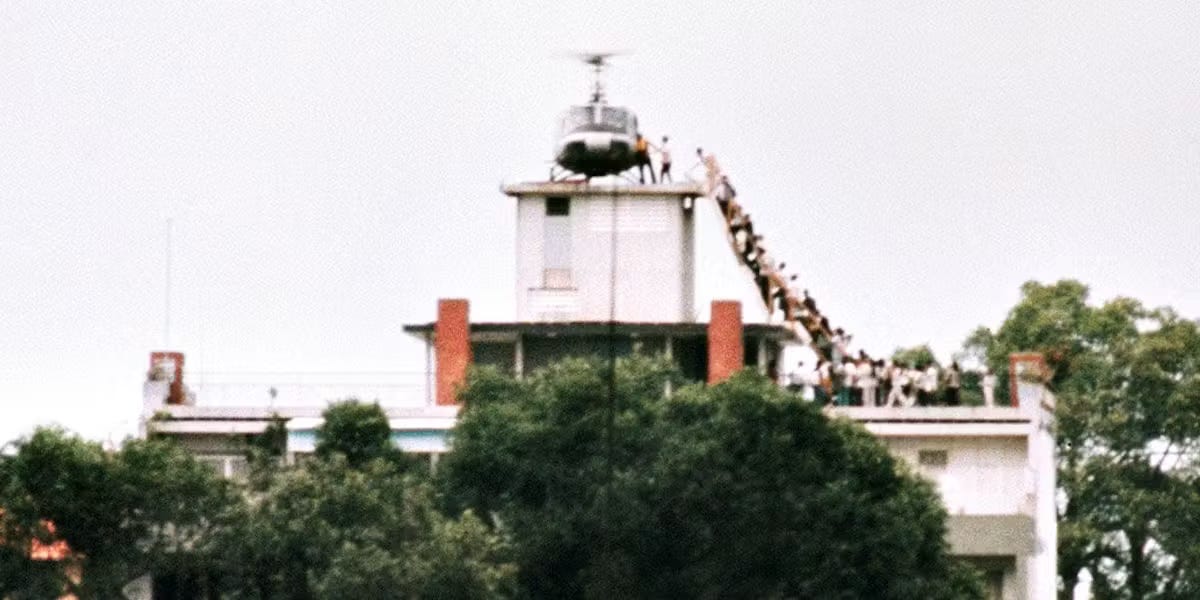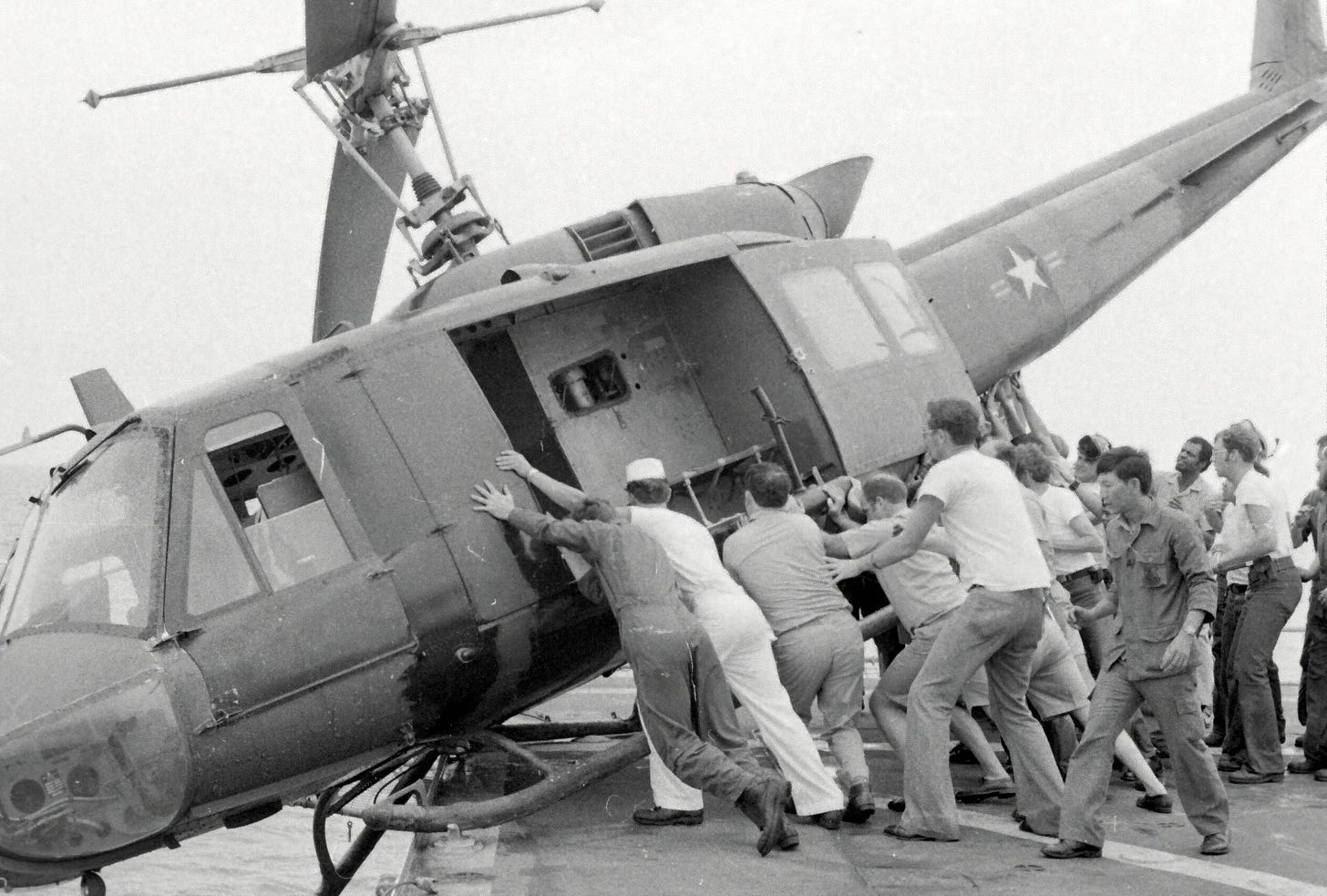The Fall of Saigon, Fifty Years Later
It was a stunning foreign policy defeat and a victory for our humanity.

To get the best sense of what took place in those final days, there are two items I cannot recommend enough. The first is Rory Kennedy’s incredible documentary from ten years ago, Last Days in Vietnam, which can be watched for free at the link with your library card. The second is this history written by three historians of the United States Air Force, Last Flight from Saigon, a free PDF made public in 2004. Both are riveting and convey the sense of what an incredible accomplishment it was. In the last eighteen hours before the North Vietnamese Army drove into Saigon, 81 helicopter flights evacuated 6000 Vietnamese and over 1000 Americans from the United States embassy. Thousands more Vietnamese were rescued through the actions taken by United States Navy personnel in various ways, which will be addressed further on.
The Vietnam War was a wholly unnecessary intervention by the United States. We worked with the Vietnamese resistance forces led by Ho Chi Minh to defeat the Japanese in World War II, promising to support their independence after the war. That promise was driven by the policy of Franklin Roosevelt, who had no intention of enabling any empire reclamation projects after the war by our allies (a fact which distressed his friend Winston Churchill greatly). When Roosevelt died, his successor Harry Truman did not feel secure enough to take the same firm stand. Having taken over after the great man’s death, a vice-president with barely any name recognition, he gave way to the pleas of Churchill and Charles de Gaulle of France. Much of that acquiesence included financing France’s return to the nation they called Indochina in 1947, taking back over like they hadn’t been driven out by the Japanese in a rout. As expected, that did not go over very well with Ho Chi Minh and his Viet Minh rebel forces…the very forces that America had fought alongside a mere two years prior, and whom had declared independence in September 1945.
We spent the next seven years funding a nation, France, that could barely take care of itself in its quixotic, and ultimately doomed, effort to retain a tropical jungle colony that did not provide any meaningful value. Why? Because we’d become convinced that there was a massive spread of Communism that had to be shut down all over the world. Was Ho Chi Minh a communist? Yep. Was he getting any help from the Soviets when we funded the French return to Vietnam? Nope. It took until three years after, until Asia had become front and center in the East-West brawl, for Stalin to begin sending funds and weapons to the Viet Minh, while at the same time aiding North Korea in the Korean War. So why, in 1947, would we even help the French reclaim a colony that wasn’t under any threat from “Soviet domination?” What was the point?
We were still asking that question as a nation in 1975, when, at long last, the Republic of Vietnam began to crumble under the weight of its own mistakes and over-reliance on America. The South Vietnamese Army began to fall apart under the onslaught of the North Vietnamese (NVA) Army, who unlike them, had not lost their sponsors. While the pipeline had definitely slowed up from what it was, the Chinese and the Soviets had continued to fuel them with weapons and supplies. Our country, on the other hand, had decided that getting out meant getting out, and we did.
My uncle was drafted to Vietnam in Nixon’s first term, and came home with a colostomy bag for his troubles. As a young man in the 70s, that affected the rest of his life, and ultimately contributed to his early death when I was around the age that he was when he was drafted. I absolutely would’ve been in the streets protesting the war. And despite all that, I also think the way we, as a nation, decided to stop arming South Vietnam and left them to fall apart was another moral abomination. We spent twenty years, from 1954-1974, being their backstop, because it had long stopped being a civil war and turned into a proxy war—a proxy war that we were largely responsible for. We should never have gone in, but as with Iraq twenty years ago, once you go in, once you break something, you ought to fix it. We didn’t.
What did happen, though, was a tremendous individual effort by American diplomats, soldiers, and CIA officers to evacuate as many South Vietnamese as possible when it became clear that the war was coming to a close. The ambassador in Saigon during these last days was a crusty old Yankee named Graham Martin, who spoke with the mid-Atlantic accent that Cary Grant made famous. He was slow to accept that Saigon would fall, and refused to start evacuations until there was no hope of saving it, a fact which greatly slowed the destruction of intelligence records with the names of South Vietnamese who aided America’s efforts.
To ensure that they could start saving people, the CIA officers and defense attaches at the Saigon embassy went out and tracked down the people who fought for their nation, people who worked in the embassy, people who even did minor things like tailoring, and worked to get them out safely. The embassy staff worked 18 and 24-hour shifts processing asylum applications, creating Social Security cards, taking photos for passports, and going around to apartment buildings (as shown in the photo at the top) to pick up families. One of those who helped organize that effort at the apartments was later pulled aside by the Ambassador, expecting a scolding for being defeatist, and was instead praised for his initiative.
When Martin could no longer deny that the end was near, President Ford dispatched over fifty naval ships and a detachment of Marine helicopters to assist the evacuations of Americans from Saigon in Operation FREQUENT WIND. Those naval ships would receive visits from special forces officer Richard Armitage (the future deputy secretary of state to Colin Powell), who roused them to take in refugees as well. The captains allowed for South Vietnamese-piloted helicopters to land on their decks to disgorge refugees, and then the helicopters were dumped overboard to make room for the next.
The chartered airplanes and cargo flights being used for evacuation were filled to the brim with refugees, and in many cases, American staff that were supposed to leave would get off so extra refugees could get on. As one of the staffers says in Last Days in Vietnam, the evacuation wouldn’t stop until every American left, so by delaying their own departures, they could save more people. Given the notoriously violent torture that captured Americans were put through by Viet Cong (the Viet Minh successors) or North Vietnamese captors, it was a remarkably brave action to take. The Marine helicopter pilots managing the evacuation worked constantly for days, ferrying loads of people every single time they flew, especially after the concurrent airlift from Tan Son Nhut airbase in Saigon had to halt when the NVA shelled the airport, wrecking aircraft and putting craters in the runways. Ambassador Martin was so intent on getting as many out as possible that he insisted on going to Tan Son Nhut to inspect the damage himself, despite the pleadings of his security team. Only after Graham walked out on the tarmac and saw the smoking ruins of aircraft and the cratered runway did he accept the airlift component had to stop.
Martin then refused to leave until we got everyone out, and it required a presidential order to Marine security forces to physically take him onto a helicopter and depart the embassy. The last to go were the Marine security detachment at the embassy, who were almost forgotten in the chaos and were helicoptered out as NVA armored vehicles rolled into Saigon. At sea, the navy worked to escort multiple South Vietnamese freighters crowded with refugees to safe harbor in the Philippines. When Ferdinand Marcos, the Filipino president, refused to take those refugees because he had immediately acknowledged the North Vietnamese as the only government in Vietnam, Armitage and one of the ship captains decided to flag the freighters as American vessels, allowing them to be docked at Subic Bay, our large naval station in the Phillipines.
In case after case, lower ranking officials risked their careers and safety to evacuate as many of the people who had believed in America, despite the many crimes and cruelties we’d inflicted upon Vietnam in service of supposedly “saving” it. 130,000 South Vietnamese were evacuated in those final days, an act of grace that was long overdue. Had an ounce of that care been shown in the years and decades before, so many would not have died in vain. There was too much focus on “fighting Communism” and not nearly enough on improving the lives of the Vietnamese. America was fighting an esoteric battle, while the North Vietnamese fought for their homeland and their closely-held and cherished beliefs. We never stood a chance, never should have fought that war, and conducted much of it with absolutely no consideration for the well-being of our alleged allies.
The Vietnam War was one of the darker chapters in our nation’s history, but the last days of Saigon were an example of the best of us. Many of those we took in became outstanding citizens, contributing to America in ways we couldn’t have imagined in 1975. They came with nothing, and they worked their way up the ladder. From janitors to Fortune 500 senior executives, from orphaned child to millionaire real estate broker, from farmer to owners of doughnut shops, with engineers, attorneys, and so much more in between. They are a shining example of how immigration enriches this nation, something I desperately hope the people of America begin remembering as our current fascist leaders try to run everyone out of the country.
May we never have another Vietnam War, and may we once again live up to our best ideals as we did in April 1975.





Lived thru this but didn’t know much of what you reported. Puts in high relief our current history.
Thank you.